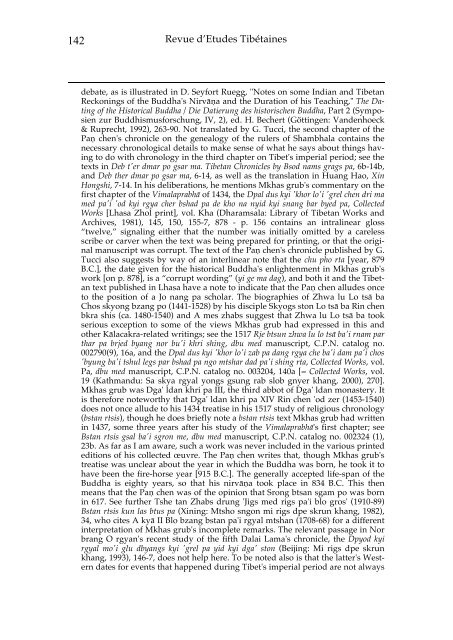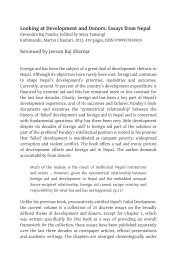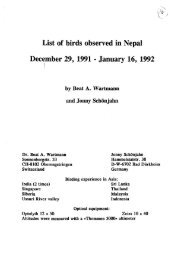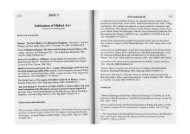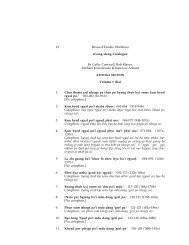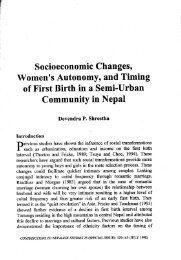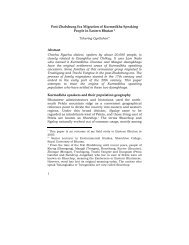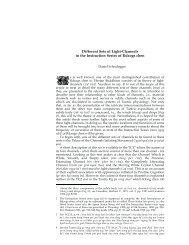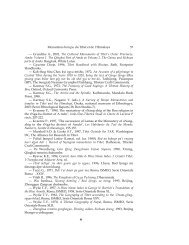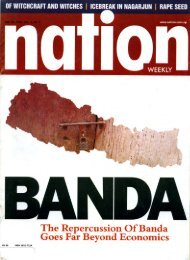Some Remarks on the Textual Transmission and Text of Bu ston
Some Remarks on the Textual Transmission and Text of Bu ston
Some Remarks on the Textual Transmission and Text of Bu ston
Create successful ePaper yourself
Turn your PDF publications into a flip-book with our unique Google optimized e-Paper software.
142<br />
Revue d’Etudes Tibétaines<br />
debate, as is illustrated in D. Seyfort Ruegg, "Notes <strong>on</strong> some Indian <strong>and</strong> Tibetan<br />
Reck<strong>on</strong>ings <strong>of</strong> <strong>the</strong> <strong>Bu</strong>ddha's Nirvāṇa <strong>and</strong> <strong>the</strong> Durati<strong>on</strong> <strong>of</strong> his Teaching," The Dating<br />
<strong>of</strong> <strong>the</strong> Historical <strong>Bu</strong>ddha / Die Datierung des historischen <strong>Bu</strong>ddha, Part 2 (Symposien<br />
zur <strong>Bu</strong>ddhismusforschung, IV, 2), ed. H. Bechert (Göttingen: V<strong>and</strong>enhoeck<br />
& Ruprecht, 1992), 263-90. Not translated by G. Tucci, <strong>the</strong> sec<strong>on</strong>d chapter <strong>of</strong> <strong>the</strong><br />
Paṇ chen's chr<strong>on</strong>icle <strong>on</strong> <strong>the</strong> genealogy <strong>of</strong> <strong>the</strong> rulers <strong>of</strong> Shambhala c<strong>on</strong>tains <strong>the</strong><br />
necessary chr<strong>on</strong>ological details to make sense <strong>of</strong> what he says about things having<br />
to do with chr<strong>on</strong>ology in <strong>the</strong> third chapter <strong>on</strong> Tibet's imperial period; see <strong>the</strong><br />
texts in Deb t'er dmar po gsar ma. Tibetan Chr<strong>on</strong>icles by Bsod nams grags pa, 6b-14b,<br />
<strong>and</strong> Deb <strong>the</strong>r dmar po gsar ma, 6-14, as well as <strong>the</strong> translati<strong>on</strong> in Huang Hao, Xin<br />
H<strong>on</strong>gshi, 7-14. In his deliberati<strong>on</strong>s, he menti<strong>on</strong>s Mkhas grub's commentary <strong>on</strong> <strong>the</strong><br />
first chapter <strong>of</strong> <strong>the</strong> Vimalaprabhā <strong>of</strong> 1434, <strong>the</strong> Dpal dus kyi 'khor lo'i 'grel chen dri ma<br />
med pa'i 'od kyi rgya cher bshad pa de kho na nyid kyi snang bar byed pa, Collected<br />
Works [Lhasa Zhol print], vol. Kha (Dharamsala: Library <strong>of</strong> Tibetan Works <strong>and</strong><br />
Archives, 1981), 145, 150, 155-7, 878 - p. 156 c<strong>on</strong>tains an intralinear gloss<br />
“twelve,” signaling ei<strong>the</strong>r that <strong>the</strong> number was initially omitted by a careless<br />
scribe or carver when <strong>the</strong> text was being prepared for printing, or that <strong>the</strong> original<br />
manuscript was corrupt. The text <strong>of</strong> <strong>the</strong> Paṇ chen's chr<strong>on</strong>icle published by G.<br />
Tucci also suggests by way <strong>of</strong> an interlinear note that <strong>the</strong> chu pho rta [year, 879<br />
B.C.], <strong>the</strong> date given for <strong>the</strong> historical <strong>Bu</strong>ddha's enlightenment in Mkhas grub's<br />
work [<strong>on</strong> p. 878], is a “corrupt wording” (yi ge ma dag), <strong>and</strong> both it <strong>and</strong> <strong>the</strong> Tibetan<br />
text published in Lhasa have a note to indicate that <strong>the</strong> Paṇ chen alludes <strong>on</strong>ce<br />
to <strong>the</strong> positi<strong>on</strong> <strong>of</strong> a Jo nang pa scholar. The biographies <strong>of</strong> Zhwa lu Lo tsā ba<br />
Chos sky<strong>on</strong>g bzang po (1441-1528) by his disciple Skyogs st<strong>on</strong> Lo tsā ba Rin chen<br />
bkra shis (ca. 1480-1540) <strong>and</strong> A mes zhabs suggest that Zhwa lu Lo tsā ba took<br />
serious excepti<strong>on</strong> to some <strong>of</strong> <strong>the</strong> views Mkhas grub had expressed in this <strong>and</strong><br />
o<strong>the</strong>r Kālacakra-related writings; see <strong>the</strong> 1517 Rje btsun zhwa lu lo tsā ba'i rnam par<br />
thar pa brjed byang nor bu'i khri shing, dbu med manuscript, C.P.N. catalog no.<br />
002790(9), 16a, <strong>and</strong> <strong>the</strong> Dpal dus kyi 'khor lo'i zab pa dang rgya che ba'i dam pa'i chos<br />
'byung ba'i tshul legs par bshad pa ngo mtshar dad pa'i shing rta, Collected Works, vol.<br />
Pa, dbu med manuscript, C.P.N. catalog no. 003204, 140a [= Collected Works, vol.<br />
19 (Kathm<strong>and</strong>u: Sa skya rgyal y<strong>on</strong>gs gsung rab slob gnyer khang, 2000), 270].<br />
Mkhas grub was Dga' ldan khri pa III, <strong>the</strong> third abbot <strong>of</strong> Dga' ldan m<strong>on</strong>astery. It<br />
is <strong>the</strong>refore noteworthy that Dga' ldan khri pa XIV Rin chen 'od zer (1453-1540)<br />
does not <strong>on</strong>ce allude to his 1434 treatise in his 1517 study <strong>of</strong> religious chr<strong>on</strong>ology<br />
(bstan rtsis), though he does briefly note a bstan rtsis text Mkhas grub had written<br />
in 1437, some three years after his study <strong>of</strong> <strong>the</strong> Vimalaprabhā's first chapter; see<br />
Bstan rtsis gsal ba'i sgr<strong>on</strong> me, dbu med manuscript, C.P.N. catalog no. 002324 (1),<br />
23b. As far as I am aware, such a work was never included in <strong>the</strong> various printed<br />
editi<strong>on</strong>s <strong>of</strong> his collected œuvre. The Paṇ chen writes that, though Mkhas grub's<br />
treatise was unclear about <strong>the</strong> year in which <strong>the</strong> <strong>Bu</strong>ddha was born, he took it to<br />
have been <strong>the</strong> fire-horse year [915 B.C.]. The generally accepted life-span <strong>of</strong> <strong>the</strong><br />
<strong>Bu</strong>ddha is eighty years, so that his nirvāṇa took place in 834 B.C. This <strong>the</strong>n<br />
means that <strong>the</strong> Paṇ chen was <strong>of</strong> <strong>the</strong> opini<strong>on</strong> that Sr<strong>on</strong>g btsan sgam po was born<br />
in 617. See fur<strong>the</strong>r Tshe tan Zhabs drung 'Jigs med rigs pa'i blo gros' (1910-89)<br />
Bstan rtsis kun las btus pa (Xining: Mtsho sng<strong>on</strong> mi rigs dpe skrun khang, 1982),<br />
34, who cites A kyā II Blo bzang bstan pa'i rgyal mtshan (1708-68) for a different<br />
interpretati<strong>on</strong> <strong>of</strong> Mkhas grub's incomplete remarks. The relevant passage in Nor<br />
brang O rgyan's recent study <strong>of</strong> <strong>the</strong> fifth Dalai Lama's chr<strong>on</strong>icle, <strong>the</strong> Dpyod kyi<br />
rgyal mo'i glu dbyangs kyi 'grel pa yid kyi dga' st<strong>on</strong> (Beijing: Mi rigs dpe skrun<br />
khang, 1993), 146-7, does not help here. To be noted also is that <strong>the</strong> latter's Western<br />
dates for events that happened during Tibet's imperial period are not always


